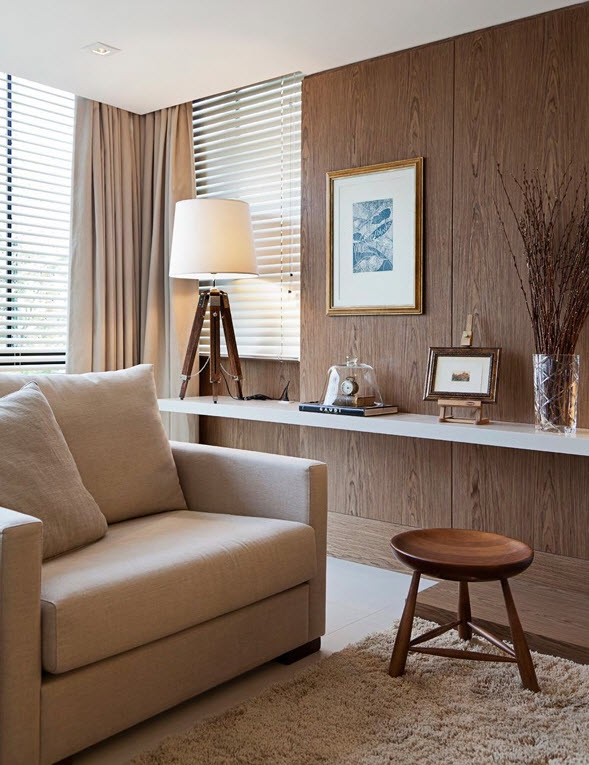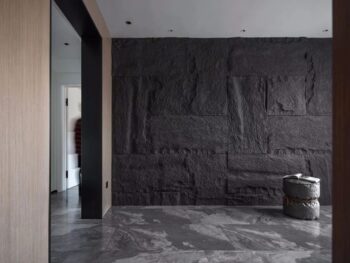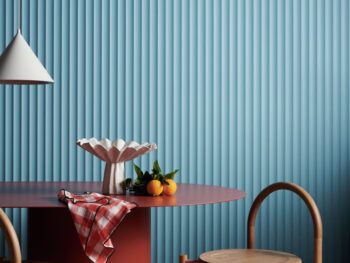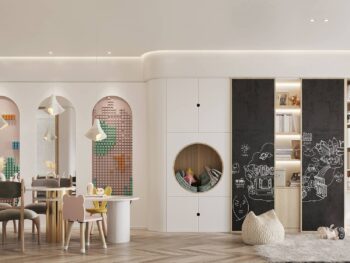
Choose Solid Wood Wall Panels or PVC Wall Panels?
When decorating an interior, choosing the right materials for wall decoration is an important and complex decision. Wall paneling is one of the key elements in decorating an interior space. It not only affects the aesthetics and style of the room, but also directly affects the durability and maintenance needs of the wall. Two common siding options are solid wood siding and PVC siding, each of which has its own set of advantages and limitations and is suitable for different renovation projects and needs.
In this article, we will compare solid wood wall panels and PVC wall panels to explore their differences in material composition, durability, aesthetics, waterproofness, installation difficulty, customizability, price, and environmental friendliness. This will help you better understand the characteristics of both types of wall panels so you can make informed decisions when choosing wall covering materials. Whether you’re working on a home renovation or a commercial project, choosing the right siding material will have a significant impact on the final interior environment and finish.
Related Articles
Comparison of Solid Wood Wall Panel and WPC Wall Panel
Solid Wood vs MDF: Which Wall Panel Is Right for Your Home Decor?
MDF vs PVC Wall Panels: Comparison of the Differences
Choose MDF or WPC Wall Panels?
I. Introduction to solid wood wall panels
Solid wood wall panel is a wall panel material used for interior decoration. It is made of solid wood, usually cut, processed and made from pieces of wood. These woods are usually from different types of trees, such as pine, oak, birch, walnut, etc., and can be selected according to decorative needs and personal taste.
Solid wood wall panels have the advantages of natural beauty, durability, environmental protection and good decorative properties. However, it should be noted that solid wood wall panels also have some potential problems, including higher price, complicated installation, easy to get damp, deformation and discoloration, etc. Additionally, solid wood siding requires regular maintenance to maintain its beauty and performance.
Overall, solid wood wall panels are a high-quality, beautiful and environmentally friendly interior decoration material that brings natural warmth and style to a room. However, its features and suitability need to be carefully considered when selecting it to ensure it meets project needs.
II. What are the advantages and disadvantages of solid wood wall panels?
Advantages
Solid wood wall panels have many advantages that make them a popular choice for interior decoration. Here are some of the key benefits of solid wood siding:
1. Natural beauty
Solid wood siding is prized for its natural beauty. Each solid wood wall panel has a unique wood grain, color and texture, bringing a warm and natural atmosphere to the interior space.
2. High quality appearance
Solid wood wall panels provide a high-quality appearance and give interior spaces more texture and taste. They are suitable for traditional, classic and cozy decoration styles.
3. Durability
Properly maintained solid wood siding is very durable. They stand the test of time and resist scratches, scuffs and fatigue.
4. Repairability
If solid wood siding is scratched or damaged, it can usually be repaired by sanding and repainting it back to its original condition.
5. Environmentally friendly
Solid wood siding is often a sustainable choice because they use natural wood, helping to reduce the need for forest resources.
6. Hygroscopicity
Solid wood wall panels have certain hygroscopic properties, which can help regulate indoor humidity and increase comfort in dry environments.
7. Appreciation potential
Installing solid wood siding can increase the value of your home as they are considered a high-end and high-quality finishing option.
8. Customizability
Solid wood wall panels can be easily customized into a variety of shapes and designs to suit specific decorative needs.
9. Sound absorption performance
Solid wood wall panels have sound-absorbing properties to a certain extent, which can reduce indoor noise transmission and provide a quieter environment.
10. Enhance temperature stability
Solid wood wall panels are relatively insusceptible to moisture or temperature changes, and do not expand or contract easily.
Overall, solid wood wall panels stand out for their natural beauty, high-quality appearance, and durability, making them suitable for a variety of decorating projects and decorating styles. Whether in the living room, bedroom, dining room or other indoor areas, solid wood wall panels can enhance the texture and taste of the space.
Disadvantages
Although solid wood siding offers many advantages, there are also some disadvantages and limitations that need to be considered when choosing. Here are some of the main disadvantages of solid wood siding:
1. High cost
Solid wood siding generally costs more because they are made from natural wood, and different types of wood have different prices. This may make solid wood siding unsuitable for renovation projects with a limited budget.
2. Requires regular maintenance
Solid wood siding requires regular maintenance, including painting, cleaning and maintenance, to maintain its appearance and durability. If not properly maintained, wood can become dull or damaged.
3. Affected by the environment
Solid wood siding is very sensitive to environmental conditions. Moist conditions can cause wood to swell, warp, or develop mold. Therefore, it is not suitable to use solid wood wall panels in wet areas such as bathrooms or kitchens.
4. Vulnerable to physical damage
Although solid wood siding is relatively strong, it is still susceptible to physical damage such as scratches, dents, and impacts. This may require additional repairs and maintenance.
5. Limited customizability
Solid wood wall panel designs are limited by the limitations of natural wood, so highly customized designs may not be possible in some cases.
6. Sustainability issues
The use of solid wood wall panels can raise sustainability issues because they rely on limited forest resources. Ensuring that you choose a wood supplier that comes from sustainably managed sources can mitigate this problem.
7. Discoloration problem
Solid wood siding may change color over time, depending on the wood species and degree of exposure to sunlight. This can lead to an uneven appearance.
8. Installation requirements
Installing solid wood siding can require more skill and time, especially when working with different wood textures and joints.
While solid wood siding offers unique beauty and durability, these advantages and disadvantages need to be weighed when selecting to ensure they are suitable for the specific renovation project and environmental conditions.

III. Introduction to PVC wall panels
PVC wall panel is an interior decoration material. It is a wall panel material made of polyvinyl chloride (PVC) resin and other additives. It is also known as PVC siding or PVC decorative panel. PVC boards are widely used as cladding materials for walls and ceilings. They are versatile and can be used as an alternative to mineral fiber materials such as gypsum or POP. They can replace wall tiles in bathrooms and can also be used as decorative wall panels in place of materials such as MDF or wallpaper. So, if you are looking for alternatives to these traditional materials, find out if PVC walls and ceilings are the right choice.
PVC wall panels are usually used to decorate interior walls, and are especially suitable for areas with damp or high humidity, such as bathrooms, kitchens, laundry rooms, etc. This is because the PVC material itself is resistant to water, moisture and mildew, making it very practical in these areas.
PVC wall panels are hollow items used for interior wall cladding and ceilings. Due to their hollow parts, they are lighter in weight. They feature tongue-and-groove connectors for faster, easier installation. PVC wall panels are used as decorative materials in home interiors, similar to wallpaper.
PVC (polyvinyl chloride) ceiling tiles are widely used as cladding material for ceilings in residential and commercial buildings. Each panel has a hollow core and a smooth, shining surface. PVC is a durable, lightweight plastic that is manufactured in factories into ceiling tiles in a variety of designs, colors, sizes, and lengths. In damp spaces like balconies, bathrooms, and basements, these panels are the greatest replacement for traditional mineral fiber ceilings like POP and plaster since they are waterproof.
PVC wall panels are available on the market in a variety of colors, textures, and designs that can mimic wood grain, stone grain, and other decorative effects. This makes it a popular interior decoration option that can bring beauty and style to a room.
Overall, PVC wall panels are a practical, economical and beautiful wall decoration material, especially suitable for areas that need to be waterproof and easy to clean.
IV. What are the advantages and disadvantages of PVC wall panels?
Advantages
PVC (polyvinyl chloride) wall panels have many advantages, making them one of the preferred materials for many people when it comes to interior decoration and wall decoration. Here are some of the main advantages of PVC wall panels:
1. Durability
PVC wall panels are very durable and will not easily wear, warp or rot. They can last for years without losing appearance or performance.
2. Waterproof
PVC wall panels have excellent waterproof properties, making them ideal for use in humid environments such as bathrooms, kitchens and laundry rooms. They do not absorb water and are not affected by moisture.
3. Easy to clean
PVC wall panels have a smooth surface and do not attract dust, dirt or bacteria, making them very easy to clean. Just wipe with a damp cloth to keep it clean.
4. Resist stains
PVC siding is generally resistant to common stains such as paint, ink, beverages, etc., which makes them easier to keep clean.
5. Resistant to mold and fungus
Due to its waterproof properties, PVC wall panels are not susceptible to the growth of mold, fungi and bacteria, helping to maintain clean and hygienic indoor air.
6. Diversity
PVC wall panels offer a wide range of design and color options to suit a variety of decorating styles and needs. They can imitate the appearance of other materials, such as wood grain, stone grain, etc.
7. Lightweight
PVC wall panels are relatively lightweight and easy to transport and install. This reduces the ease and cost of installation.
8. Sound insulation
PVC wall panels have certain sound insulation properties, which can reduce noise transmission and provide a quieter indoor environment.
9. Environmental protection
PVC wall panels are generally recyclable and use relatively little material in the production process, making them somewhat environmentally friendly.
10. Affordable
PVC wall panels are generally relatively low-priced, making them an affordable decorative material choice.
Overall, PVC wall panels are durable, waterproof, easy to clean, stain and mold resistant, versatile and affordable, making them an ideal choice for many renovation projects. Whether for commercial premises or home decoration, PVC wall panels can provide beautiful, practical and sustainable decorative solutions.
Disadvantages
Although PVC (polyvinyl chloride) wall panels have many advantages, there are also some disadvantages that need to be considered when selecting and using them. Here are some of the main disadvantages of PVC wall panels:
1. Not suitable for high temperature environment
PVC wall panels are not resistant to high temperatures and may soften, deform, or fade when exposed to high temperatures for extended periods of time. Therefore, it is not recommended for use in areas that are subject to frequent high temperatures, such as outdoor walls exposed to sunlight.
2. Not resistant to freezing environment
Contrary to high temperatures, PVC wall panels are also not suitable for extremely cold environments. In extreme cold temperatures, PVC can become brittle and prone to cracking.
3. Release of harmful gases
During the manufacturing and processing of PVC, some harmful gases, such as chlorine, may be released. These gases may pose potential risks to worker health and the environment. Therefore, waste PVC materials need to be handled and disposed of with care.
4. Irrepairability
Unlike some other siding materials, such as solid wood or drywall, PVC siding is often difficult to repair. In the event of severe physical damage, the entire plate may need to be replaced.
5. Does not have absolute impact resistance
Although PVC wall panels are relatively strong, they are not absolutely impact resistant. Damage can still occur when subject to strong impacts or impacts.
6. Limited texture
Although PVC wall panels can imitate the appearance of other materials, such as wood grain, stone grain, etc., they often lack the texture and texture of real materials. For those looking for a natural beauty, this may not be the best option.
7. Not absolutely environmentally friendly
Although PVC wall panels can be recycled, their production and disposal can have some impact on the environment. In addition, some PVC wall panels may contain dangerous additives, so you need to choose environmentally friendly and harmless products.
8. Flammability
PVC materials are prone to burning and releasing toxic gases when exposed to flames or high temperatures. Therefore, you need to pay attention to fire safety when using PVC wall panels.
In summary, although PVC wall panels have advantages in many aspects, there are also some potential disadvantages and limitations. When selecting PVC wall panels as a decorative material, specific environmental conditions, preferences and needs need to be taken into consideration, and appropriate precautions need to be taken to reduce potential risks.

V. Comparison of the differences between solid wood wall panels and PVC wall panels
The following is a comparison of the differences between solid wood wall panels and PVC (polyvinyl chloride) wall panels:
Items |
Solid Wood Wall Panel |
PVC Wall Panel |
Material |
Solid wood siding is made from natural wood, usually solid wood planks from a variety of tree species. This gives each solid wood wall panel a unique wood grain and color, providing a natural beauty and warmth. | PVC wall panels are made of polyvinyl chloride, a man-made plastic. They often have a smooth surface and can be printed in a variety of textures and colors, but often lack the authentic feel of wood. |
Durability |
Solid wood siding is very durable but requires regular maintenance such as painting and maintenance to prevent wear and rot. They are relatively vulnerable to physical damage. | PVC wall panels have high durability and are not prone to wear, deformation or moisture. They do not require regular maintenance and are better suited for use in humid environments. |
Waterproof |
Solid wood wall panels are not waterproof and easily absorb water and moisture, so they are not suitable for use in humid environments. | PVC wall panels have excellent waterproof properties and are ideal for use in wet areas such as bathrooms, kitchens and laundry rooms. |
Installation Difficulty |
Installing solid wood siding may require more skill and time, especially if you need to work with different wood textures and joint points. | PVC wall panels are relatively lightweight and easy to transport and install. They can be joined by tongue and groove or cut and machined using common woodworking tools. |
Customizability |
The customizability of solid wood siding is limited by natural wood, but a degree of personalization can be achieved by choosing different species of wood and colors. | PVC wall panels are generally easier to customize to meet a variety of design needs because they are malleable and can be printed with different textures and colors. |
Beauty |
Solid wood wall panels are prized for their unique wood grains, colors, and textures, providing a high-quality look that works well with traditional, classic, and warm decorating styles. | PVC siding can mimic the look of other materials, but often lacks the feel and grain of real wood. They are generally more suitable for modern and versatile designs. |
Environmental |
Solid wood siding is generally a natural material, but the harvesting of the wood and manufacturing process can cause some environmental stress, depending on sourcing practices. | Hazardous substances may be released during the production process of PVC wall panels. At the same time, PVC materials are recyclable, but they need to be properly handled and recycled. |
Price |
Solid wood siding generally costs more because they are made from natural wood, and different types of wood have different prices. | PVC wall panel is generally relatively affordable and is a more cost-effective decorative option. |
Depending on your renovation needs, budget and personal preferences, choosing solid wood wall panels or PVC wall panels has its advantages and disadvantages. Solid wood siding provides a natural beauty, but requires more maintenance and is not suitable for humid environments. PVC siding is waterproof and easy to maintain, making it suitable for wet areas, but may lack the authentic texture of some woods. Therefore, you need to weigh their respective characteristics when choosing.
VI. Conclusion: Weighing Choices
When comparing solid wood wall panels and PVC wall panels, we can draw the following conclusions:
Solid wood wall panels are suitable for those who seek natural beauty, warmth and traditional decorative style. They provide authentic wood texture and unique wood grain, but require more maintenance, are less tolerant of moisture and are more expensive.
PVC wall panels excel in waterproofing, durability and ease of maintenance. They are suitable for humid environments, do not require regular maintenance, and are relatively affordable. In addition, PVC wall panels are highly customizable and can meet various design needs. However, they may lack the texture of real wood, are not resistant to high temperatures and extreme cold environments, and have certain environmental concerns.
The final choice will depend on your personal needs and preferences, as well as the specific conditions of your renovation project. If you value aesthetics, are willing to take the time to maintain, and are interested in traditional wood, solid wood siding may be a better fit. And if you need wall panels that are waterproof, durable, affordable, and easy to maintain, then PVC wall panels may better suit your needs. No matter which siding you choose, you need to make sure you choose a high-quality product and install it correctly to ensure your renovation project is a success.
Quick Quotation



